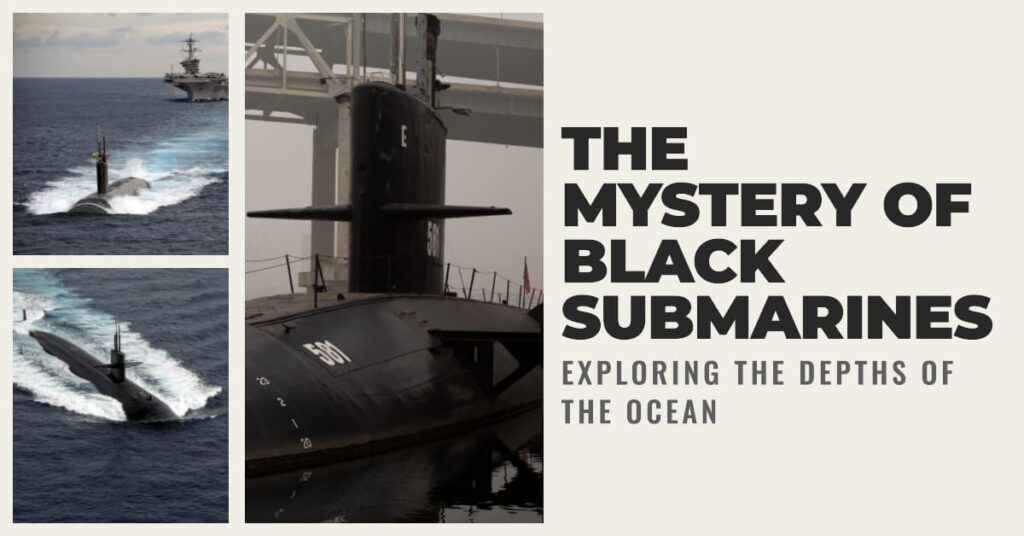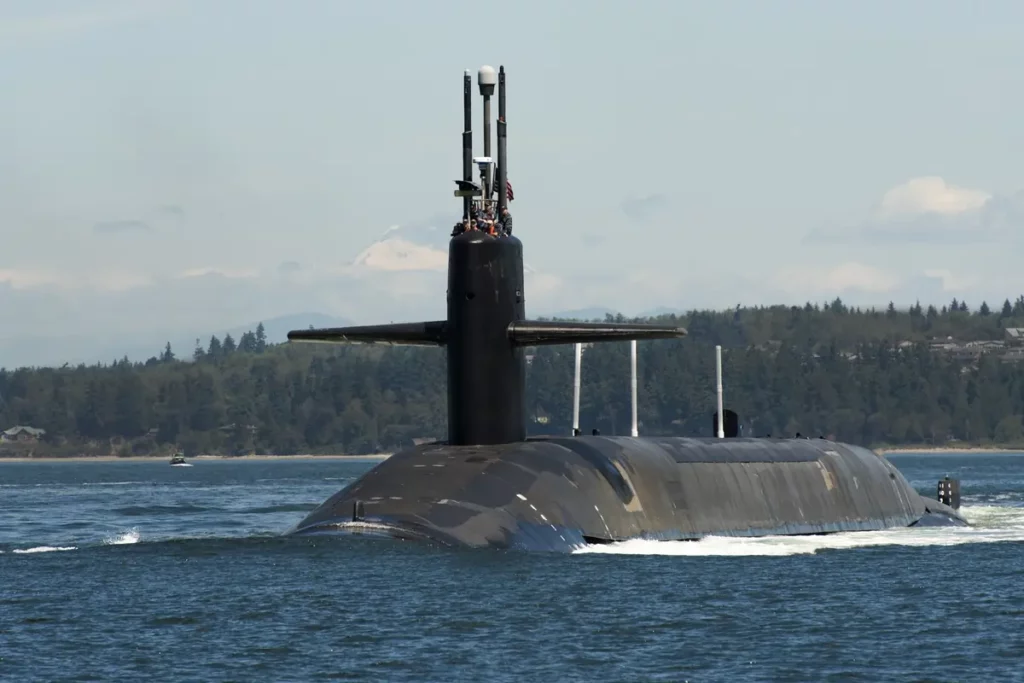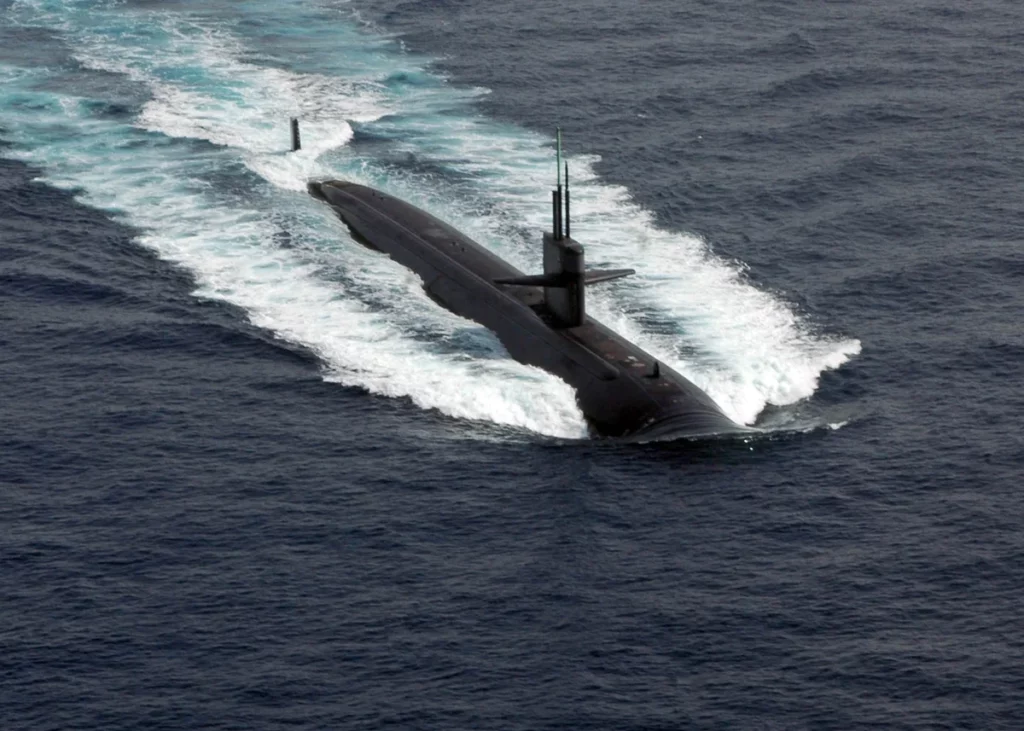Are you curious why are submarines painted black? This is a question that has puzzled many people and one that has a fascinating answer.
Submarines have always been a source of fascination for people all over the world. They are powerful and stealthy machines that can travel great distances underwater, and they are used for a variety of purposes, from scientific research to military operations. One of the most interesting things about submarines is their color.
Black is the most common color used for submarines, and there are several reasons for this. One of the main reasons is that black is a very effective camouflage color. When a submarine is painted black, it is much harder to see in the water, especially at night. This makes it easier for the submarine to remain hidden and avoid detection. Another reason why submarines are painted black is that it helps to reduce the reflection of light off the surface of the water. This is important because it makes it harder for other ships or aircraft to spot the submarine from a distance.

History of Submarine Camouflage
Submarines have been used for military purposes since the late 19th century. During World War I, submarines were painted in various colors, including white, gray, and blue. However, these colors proved ineffective in providing camouflage for the submarines.
In the 1920s, the Royal Navy began experimenting with camouflage for submarines. They painted submarines in shades of green and brown to blend in with the ocean’s colors. However, this method was only effective in shallow waters.
During World War II, the Germans developed effective camouflage for their U-boats. They used a combination of gray and blue-green to blend in with the ocean’s colors. They also used patterns to break up the submarine’s silhouette and make it harder to spot.
The Royal Navy also developed effective camouflage for their submarines during World War II. They used a combination of gray and green to blend in with the ocean’s colors. They also used patterns to break up the submarine’s silhouette and make it harder to spot.
The United States Navy developed its own submarine camouflage during World War II. They used a combination of black and gray to make the submarines harder to spot at night. The black color also made it harder for enemy ships and aircraft to see the submarines against the dark ocean.
Overall, the history of submarine camouflage shows that different navies have developed different methods to provide effective camouflage for their submarines. The Germans, Royal Navy, and United States Navy all used different colors and patterns to make their submarines harder to spot.

Color and Camouflage
Submarines are painted in dark colors to provide effective camouflage against enemy submarines, ships, and aircraft. The color of the paint helps to conceal the submarine’s presence in the vastness of the ocean, making it difficult to spot, especially at night.
Black Paint
Black is the most common color used to paint submarines. It is known to reflect the least amount of light, making it the best color for camouflaging submarines when they are surfaced, partially submerged or near the surface. The black color helps to blend in with the dark depths of the ocean, making it hard to detect submarines visually.
Dark Blue Paint
Some submarines are painted in dark blue, which is the second most common color used for submarine camouflage. The dark blue color is more effective in shallower waters, where the ocean’s color tends to be blue-green. The color helps to blend in with the water, making it harder to detect visually.
Gray Paint
Gray is another color used for submarine camouflage. The gray color is effective in waters where the ocean’s color tends to be gray. The color helps to blend in with the water, making it harder to detect visually.
Submarines are painted in different colors depending on the waters they operate in. Some countries paint their submarines in two colors to provide better camouflage in different water conditions.
In conclusion, the color of the paint used to camouflage submarines is crucial to their effectiveness in avoiding detection. Black color is the most common color used for submarine camouflage because it reflects the least amount of light. However, dark blue and gray colors are also used depending on the water conditions.

Sound Detection and Submarines
Submarines rely heavily on sound detection to navigate and locate other vessels in the ocean. Because of this, sound is a critical factor in submarine design.
Passive Sonar
Passive sonar is a system used by submarines to detect sound waves emitted by other vessels in the ocean. Passive sonar is a listening device that can detect sound waves from hundreds of miles away. The system is designed to detect sound waves emitted by other vessels, such as ships or submarines, without emitting any sound waves of its own.
Submarines use passive sonar because it is difficult for other vessels to detect the submarine’s presence. The submarine can listen to the sound waves emitted by other vessels, without alerting those vessels to its presence.
Active Sonar
Active sonar is a system used by submarines to emit sound waves and detect the reflections of those waves off other vessels in the ocean. Active sonar is used when a submarine needs to locate a specific vessel or object in the ocean.
When a submarine emits a sound wave, it travels through the water until it reaches an object. The sound wave then bounces back to the submarine, where it is detected by the active sonar system. The time it takes for the sound wave to travel to the object and back to the submarine is used to calculate the distance between the submarine and the object.
However, active sonar can be detected by other vessels in the ocean. The sound waves emitted by the submarine can be heard by other vessels, which can use that information to locate the submarine.
Because of this, submarines rely more heavily on passive sonar to detect other vessels in the ocean. Submarines are also designed to emit as little sound as possible, to avoid detection by other vessels.
In conclusion, sound detection is a critical factor in submarine design. Submarines use passive sonar to detect other vessels without emitting any sound waves of their own. Active sonar is used when a submarine needs to locate a specific vessel or object in the ocean, but it can be detected by other vessels. Submarines rely heavily on passive sonar to avoid detection by other vessels in the ocean.

Materials Used in Submarine Construction
Submarine construction involves the use of various materials that enable it to withstand the harsh marine environment. The materials used in the construction of submarines must be strong, durable, and resistant to corrosion. In this section, we will discuss the various materials used in submarine construction, including anechoic tiles, synthetic polymer tiles, carbon black, and epoxy-based red marine paint.
Anechoic Tiles
Anechoic tiles are rubber tiles that are used to absorb sound waves. These tiles contain thousands of tiny voids that absorb sound waves from active sonars, making the submarine acoustically stealthy. The tiles are usually black in color, which helps to camouflage the submarine from visual detection.
Synthetic Polymer Tiles
Synthetic polymer tiles are another material used in submarine construction. These tiles are made from a synthetic polymer composite material that is reinforced with carbon fibers. The tiles are lightweight, strong, and have a high tensile strength, which makes them ideal for use in submarines.
Carbon Black
Carbon black is a type of carbon that is used as a pigment in submarine paint. The black pigment helps to camouflage the submarine from visual detection. Carbon black is also used in the production of anechoic tiles, which are black in color.
Epoxy-Based Red Paint
Epoxy-based red paint is used in the construction of submarines to protect the hull from corrosion. The paint is applied in several layers to ensure maximum protection. The red color of the paint helps to identify any areas of the hull that require maintenance.
In conclusion, the materials used in submarine construction are carefully selected to ensure that the submarine can withstand the harsh marine environment. Anechoic tiles, synthetic polymer tiles, carbon black, and epoxy-based red paint are just a few of the materials used in submarine construction. These materials are chosen for their strength, durability, and resistance to corrosion.
Impact of Environment on Submarine Color
Submarines are painted black for several reasons, including visual protection and camouflage against enemy ships, aircraft, and submarines. However, the color of a submarine can also be influenced by the environment in which it operates. In this section, we will explore the impact of the environment on submarine color, with a focus on coastal waters and deep-sea exploration.
Coastal Waters
Submarines that operate in coastal waters are often painted with a lighter color, such as gray or blue. This is because the water in coastal areas tends to be shallower and clearer than in the open ocean, which makes it easier to spot submarines. A lighter color can help a submarine blend in with its surroundings and make it less visible to the naked eye.
However, even in coastal waters, submarines may still be painted black for additional protection against detection by sonar. The color black absorbs sound waves, making it more difficult for sonar to detect a submarine. Additionally, black can help prevent barnacle growth on the hull of the submarine, which can slow it down and increase fuel consumption.
Deep-Sea Exploration
Submarines that are used for deep-sea exploration are often painted black or dark blue. This is because the water in the deep sea is much darker than in coastal waters, and a darker color can help a submarine blend in with its surroundings. Additionally, the color black can help absorb light and reduce the visibility of the submarine, making it less likely to be detected by other ships or submarines.
In deep-sea environments, submarines may also be painted with a special coating to prevent corrosion from the saltwater. This coating can also help reduce drag and improve the speed and maneuverability of the submarine.
In conclusion, the color of a submarine can be influenced by the environment in which it operates. Submarines that operate in shallower, clearer waters may be painted with lighter colors, while those used for deep-sea exploration are often painted black or dark blue. Regardless of the color, submarines are painted to provide visual protection and camouflage against detection by enemy ships, aircraft, and submarines.
Submarines and Other Vessels
Submarines are not the only vessels that are painted in specific colors. Other vessels, such as aircraft, ships, and torpedoes, also have their own unique color schemes. The color of these vessels is determined by various factors, such as their function, environment, and visibility.
Aircraft
Aircraft are painted in specific colors to increase their visibility, reduce their visibility, or provide camouflage. For example, military aircraft are often painted in green, brown, and black to blend in with the environment and avoid detection. On the other hand, commercial aircraft are painted in bright colors to increase their visibility and make them easier to spot in the sky.
Ships
Ships are painted in different colors depending on their function and environment. For example, naval ships are painted in gray to reduce their visibility and provide camouflage in the open ocean. On the other hand, cruise ships are painted in white to reflect sunlight and keep the interior of the ship cool.
Torpedoes
Torpedoes are painted in specific colors to increase their visibility and reduce their visibility. For example, some torpedoes are painted in bright colors, such as yellow and orange, to make them easier to spot in the water. Other torpedoes are painted in black to reduce their visibility and provide camouflage.
In summary, the color of submarines and other vessels is determined by various factors, such as their function, environment, and visibility. The color of these vessels plays an important role in their effectiveness and ability to perform their intended function.
Modern Submarines and Color Schemes
Submarines have come a long way since their inception in the early 20th century. Modern submarines are equipped with advanced technology and are designed to perform a wide range of missions. One aspect of modern submarines that has remained constant is their color scheme. Most submarines are painted black, and there are good reasons for this.
The US Navy is one of the largest operators of submarines in the world. The Navy’s submarines are painted black to help them blend in with the surrounding water and make them more difficult to detect. The black paint also helps to absorb heat and reduce the submarine’s infrared signature, making it less visible to thermal imaging systems.
In addition to their black paint scheme, US Navy submarines also have a non-skid deck coating that is designed to provide better traction for crew members. This coating is typically a light gray color, which helps to reduce glare and make it easier for crew members to see in bright sunlight.
The Indian Navy is another major operator of submarines, and their submarines are also painted black. However, the Indian Navy uses a slightly different paint scheme than the US Navy. Indian Navy submarines have a black upper hull and a light gray lower hull. This paint scheme is designed to help the submarines blend in with both the surface and the depths of the ocean.
In addition to their paint scheme, Indian Navy submarines also have a non-skid deck coating that is similar to the US Navy’s. The coating is designed to provide better traction for crew members and is typically a light gray color.
Overall, the color scheme of modern submarines is an important aspect of their design. The black paint helps to reduce the submarine’s visibility and make it more difficult to detect, while the non-skid deck coating provides better traction for crew members. Whether operated by the US Navy or the Indian Navy, modern submarines are designed to be as stealthy as possible, and their color scheme plays a key role in achieving that goal.
Frequently Asked Questions
What is the reason behind submarines being painted black?
Submarines are painted black primarily for camouflage. The color black provides effective concealment against enemy submarines, ships, and aircraft. Black submarines are difficult to spot in the vastness of an ocean, especially at night.
What advantage does black paint provide to submarines?
Black paint helps submarines blend in with their surroundings and remain hidden. It also reduces the reflection of light off the submarine’s surface, making it more difficult to detect.
Black paint allows submarines to blend in with the darkness of the ocean, making them nearly invisible to the naked eye. Additionally, black paint reduces the contrast of the submarine against the deep blue sea, making it more difficult to spot.
What other colors are used for submarines besides black?
While black is the most common color used for submarines, other colors have been used in the past. For example, during World War II, some submarines were painted gray or green to blend in with the ocean’s surface. However, black has been found to be the most effective color for submarine camouflage.
Navy ships are painted gray because it reduces the contrast of the ship against the horizon and reduces the vertical patterns in the ship’s appearance. This makes it more difficult for enemy ships and aircraft to detect the ship.
What is the significance of the color of paint used on submarines?
The color of paint used on submarines is significant because it can mean the difference between remaining hidden or being detected by the enemy. Black paint has been found to be the most effective color for submarine camouflage, which is why it is the most commonly used color.
- Types of Gas Carriers as per IGC Code – April 22, 2025
- Wind-Assisted Propulsion Systems (WAPS): A Game Changer for Maritime Decarbonization – February 6, 2025
- 10 Boat Salvage Yards in California – January 25, 2025




